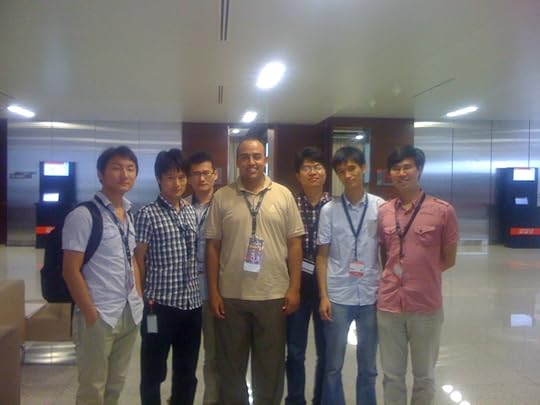Hazem Saleh's Blog, page 7
November 3, 2013
Dojo >= 1.7 Kickstart
This presentation targets the people who wants to learn the basics of Dojo (>= 1.7).
November 1, 2013
JavaScript Quiz #11
Assume that we have the following short JavaScript code:
Will this code succeed or fail? and if it succeeds, what is the output of the alert?
JavaScript Quiz #10
Assume that we have the following short JavaScript code:
Will this code succeed or fail? and if it succeeds, what is the output of the alerts?
September 17, 2013
Container-managed security for Java web applications
Web applications often need to provide security on application access (authentication) and on page access control rules (authorization). It can take a lot of time to implement these requirements from scratch to produce a secure application, but thanks to the Java Servlet specification, such common security requirements can be handled at the container level. This article explains how to apply container-managed security in Apache Tomcat in a Java web application for authentication and authorization:
Read the full article.
September 15, 2013
TypeError: invalid ‘in’ operand obj
A weird JavaScript error that you may face when using Dojo Ajax for retrieving some JSON data from the server to render on the browser. This error happens because Dojo is unable to process the resulted JSON data which is the case when handleAs attribute is set to “text”.
In order to fix this error, set handleAs attribute to “json” instead of “text” as shown below in the example:
xhr.get({
url: '/SomeServlet',
handleAs: "json",
timeout: 3000,
load: function(data) { /* Success Handling */ },
error: function(err) { /* Failure Handling */ }
});
This is my today’s two cent advice.
August 23, 2013
JavaScript Quiz #9
Assume that we have the following short JavaScript code:
What is the alert output?
August 7, 2013
Preventing anchors from scrolling to top
You may experience when clicking an anchor (which may be styled as a button) that the web page scrolls to the top which may be an un-desirable behaviour for the end user who uses the page. This post illustrates how to prevent this behavior across browsers.
July 26, 2013
Back from JavaOne China 2013

JavaOne China
I just get back from JavaOne China that was held in Shanghai 22-25 July 2013. JavaOne China is one of the biggest Java Conferences in Asia. The conference organization was good and there were a lot of attendees in the conference sessions.

JavaOne China
I had the chance to present “Efficient JavaScript Unit Testing” in 23 July, the room of the session was full of attendees and I was really amazed by the energy, enthusiasm, and responsiveness of the attendees during the session.

Photo with Chinese Developers
The session went great and I was glad to give a free copy of my JavaScript Unit Testing book to one of the attendees who answered a JavaScript quiz at the end of the session.
I uploaded my session below:
Aside from the conference, Shanghai is a modern city that has many good places to visit, I had the chance to visit three places there:
1. Yuyuan Garden and Old Town Area:
Yuyuan Garden Photos
2. Jing Temple:
Jingle Temple Photos
3. Oriental Pearl TV Tower:
Oriental Pearl TV Tower Photos
June 24, 2013
Dojo Ajaxified multi-file upload (including IE7)
One of the most common requirements of business applications is to develop Ajaxified multi-file upload. Thanks to Dojo 1.6 (and later), you can achieve this requirement, however, there are some tricks that you need to do in order to have this feature developed across all the browsers including IE. Let’s start to see the code.
The following listing shows the HTML code part of the file uploader.
<!DOCTYPE html PUBLIC "-//W3C//DTD HTML 4.01 Transitional//EN" "http://www.w3.org/TR/html4/loose.dtd&...
File Upload POC
Form Files Test
As shown the file upload HTML, the form’s enctype needs to be set to “multipart/form-data”. The form contains “uploader” div that represents the Ajaxified file upload component and “uploaderStatus” div that represents the status panel of the selected files and finally it contains the upload button that will be used for uploading.
Now, Let’s look at the JavaScript file (fileUploader.js) which uses the dojos/form/Uploader module.
require([
"dojo/parser", "dojox/form/Uploader", "dojo/dom", "dojo/on", "dojo/has",
"dojox/form/uploader/FileList", "dojox/form/uploader/plugins/IFrame",
"dojo/domReady!"],
function(parser, Uploader, dom, on, has) {
parser.parse(document.getElementById("container"));
var uploaderDIV = document.getElementById("uploader");
var up = new dojox.form.Uploader({
label: 'Select files',
style : 'background-color: #ddddff; border: solid 1px;', //Externalize ...
multiple: true,
url: "/multifile-ajax-poc/UploaderServlet"
}).placeAt(uploaderDIV);
on (dom.byId("uploadBtn"), "click", function(evt) {
//You can put some validations here ...
up.submit();
});
on (dom.byId("clearBtn"), "click", function(evt) {
dom.byId("uploaderStatus").innerHTML = "";
up.reset();
});
dojo.connect(up, "onComplete", function(dataArray) {
var i = 0;
dom.byId("uploaderStatus").innerHTML = "";
if (!dataArray.error) {
for (i = 0; i < dataArray.length; ++i) {
dom.byId("uploaderStatus").innerHTML += "File ID is: " + dataArray[i].id + " is uploaded" + "
";
}
} else {
dom.byId("uploaderStatus").innerHTML = "Unable to upload the file(s)";
}
});
dojo.connect(up, "onChange", function(evt) {
var i = 0;
var content = "";
var dataArray = up.getFileList();
for (i = 0; i < dataArray.length; ++i) {
content += dataArray[i].name + "
";
}
dom.byId("uploaderStatus").innerHTML = content;
});
up.startup();
}
);
As shown in the code, the Dojo Ajaxified file uploader is created using dojox.form.Uploader constructor with specifying the main important attributes:
1. label.
2. multiple attribute is set to true in order to support multi-file uploading.
3. url attribute is set to the Java Servlet which handles the file uploading.
In order to get the uploader working fine, you need to call startup() method of the component.
There are important methods that are needed to be considered:
1. submit() method which allows submitting the selected files to the Java Servlet specified in the url attribute.
2. reset() method which is used to clear the selected files. Note that one of the limitations of this component is that it does not allow removing the selected files individually so the only option you have is ti clear all the files and select them again.
3. getFileList() method which is used to get the list of selected files that you can display for example in the “on change” event of the component as shown by the example.
One important thing to note is dojox/form/uploader/plugins/IFrame plugin which is essential for non-HTML5 browser in order to perform Ajaxified file uploads. Using this plugin will allow file uploading to be done through iframe for poor browsers like IE7.
Finally, let’s come to the most important trick of Ajaxified file uploading which is the server side part. The following code listing shows UploaderServlet Java Servlet.
package servlets;
import java.io.IOException;
import java.io.PrintWriter;
import java.util.Iterator;
import java.util.List;
import java.util.Random;
import javax.servlet.ServletException;
import javax.servlet.annotation.WebServlet;
import javax.servlet.http.HttpServlet;
import javax.servlet.http.HttpServletRequest;
import javax.servlet.http.HttpServletResponse;
import org.apache.commons.fileupload.FileItem;
import org.apache.commons.fileupload.FileUploadException;
import org.apache.commons.fileupload.disk.DiskFileItemFactory;
import org.apache.commons.fileupload.servlet.ServletFileUpload;
@WebServlet("/UploaderServlet")
public class UploaderServlet extends HttpServlet {
private static final long serialVersionUID = 1809724554045451657L;
protected void doPost(HttpServletRequest request, HttpServletResponse response) throws ServletException, IOException {
DiskFileItemFactory factory = new DiskFileItemFactory();
ServletFileUpload upload = new ServletFileUpload(factory);
String result = "";
try {
List items = upload.parseRequest(request);
Iterator iter = items.iterator();
int index = 0;
result += "[";
while (iter.hasNext()) {
FileItem item = iter.next();
if (!item.isFormField()) {
if (index != 0) {
result += ", ";
}
String feedback = processUploadedFile(item);
//Handle IE7 ugly uploading bug
if (feedback == null) {
continue;
} else {
result += feedback;
}
++index;
System.out.println(index);
}
}
result += "]";
System.out.println(result);
} catch (FileUploadException e) {
result = "{'error':'" + e.getLocalizedMessage() + "'}";
e.printStackTrace();
}
respondToClient(request, response, result);
}
private String processUploadedFile(FileItem item) {
byte[] data = item.get();
String fileName = item.getName();
String contentType = item.getContentType();
// Handle IE7 file uploading ugly bug ...
if (fileName.equals("")) {
return null; //ignore
}
System.out.println(fileName + ", " + contentType + ", " + data.length);
return "{'fileName':'" + fileName + "', " +
"'contentType':'" + contentType + "', " +
"'size':" + data.length + ", " +
"'id':" + (System.currentTimeMillis() + new Random().nextInt(100)) + "}";
}
private void respondToClient(HttpServletRequest request, HttpServletResponse response, String result) throws IOException {
response.setContentType("text/html");
PrintWriter writer = response.getWriter();
String browser = request.getHeader("User-Agent");
if (browser.indexOf("MSIE 9") > 0 || browser.indexOf("MSIE 8") > 0 || browser.indexOf("MSIE 7") > 0 ) {
// For IE 9, 8, and 7 browser, render JSON object inside text area ...
//String sampleOutput = "[{'success':'true', 'id':'123456789'}]";
writer.write("" + result + "");
} else {
//For non-IE browsers, render normal JSON objects.
//String sampleOutput = "[{\"success\":\"true\", \"id\":\"123456789\"}]";
writer.write(result.replace("'", "\""));
}
writer.flush();
}
}
Our UploaderServlet main purpose is to receive the files and if it succeeds to process the files, then it returns a simple array with the basic information of the files that are successfully uploaded.
The most important thing to notice here is for IE7 and IE8 and IE9 (NOT IE 10), a special handling is needed to be taken into consideration in the Servlet response:
1. The response data must be wrapped into textarea field.
2. Do not use double quotes (“) inside the returned JSON array, instead use single quote (‘).
In other modern browsers (which support HTML5 file uploading), you do not need to wrap the content in textarea as it does not use iframe for uploading, and you can freely use the double quotes (“) in the JSON array.
There is an ugly bug that you need to take care about in IE 7 and 8 and also 9 with the Dojo file uploader component, this bug is about having a redundant file with non-name that is always sent in the request of the multiple-file Ajax uploading. In order to handle this bug, just ignore the file which does not have a name (Ugly problem and ugly fix  ).
).
This is all about my experience in this component, I wish that it can be helpful to you.
May 30, 2013
Creating JSF RESTful pages
In a web browser, a bookmark allows users to get back to a given web page at any time. Users can share bookmarkable pages with other users by just sharing a page URL (with its required parameters). Bookmarkable pages are also friends to search engines because they can be indexed by search crawlers. Sometimes you might want to create a bookmarkable page programmatically, with Java for instance. Here’s how to create bookmarkable pages in Java EE applications using the JavaServer Faces (JSF) framework.



